Home > Directory Home > Drawing Lessons > Drawing for Beginners >How to Find Colors and Use Them in Your Drawings
How to find colors and use colors in your drawings with color theory
|
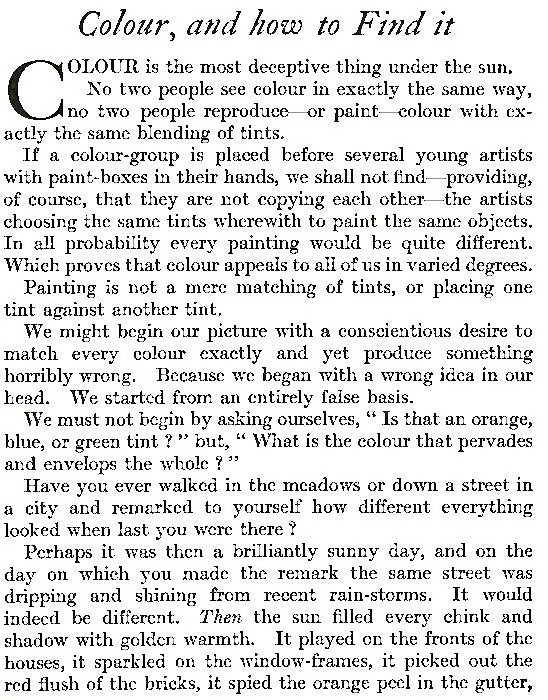
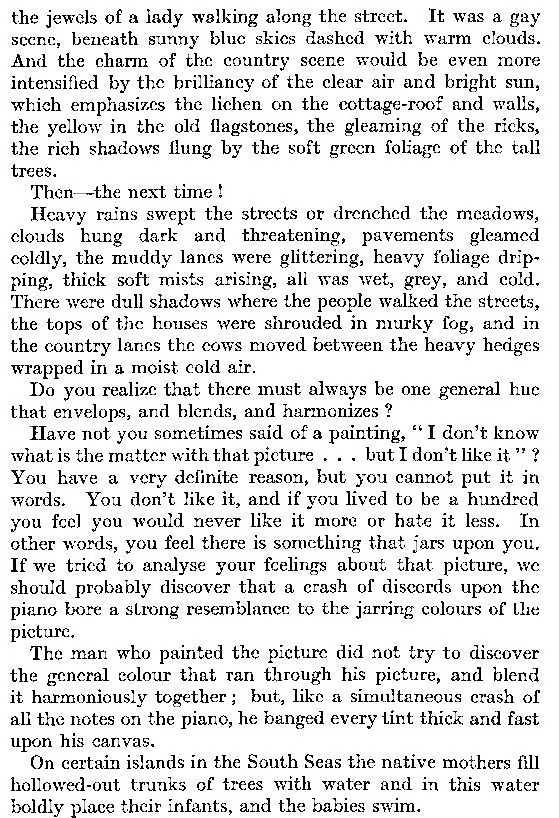
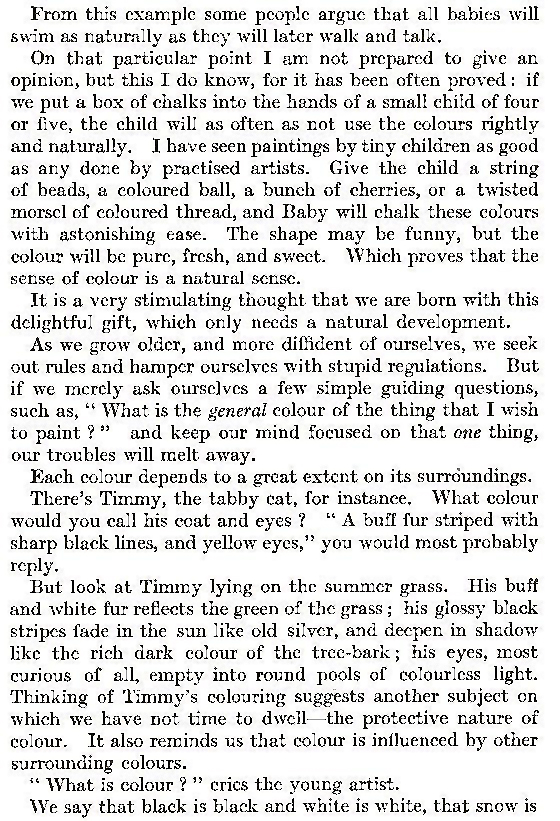
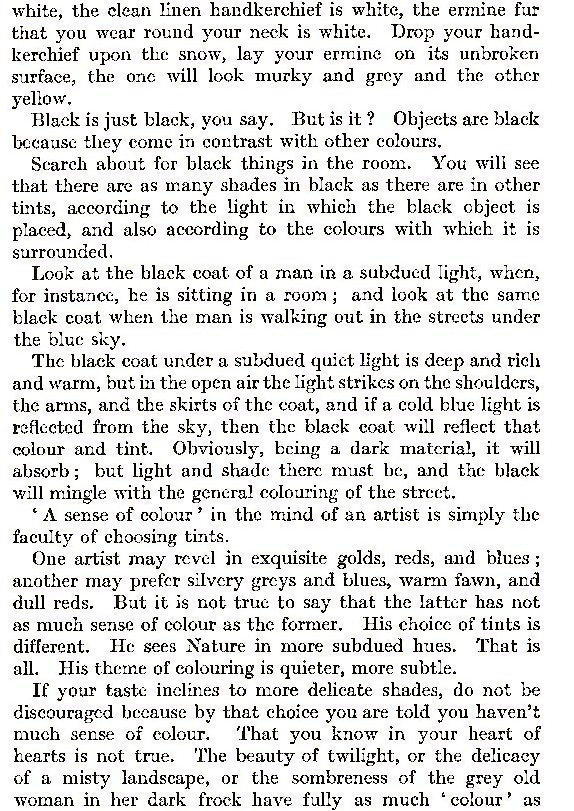
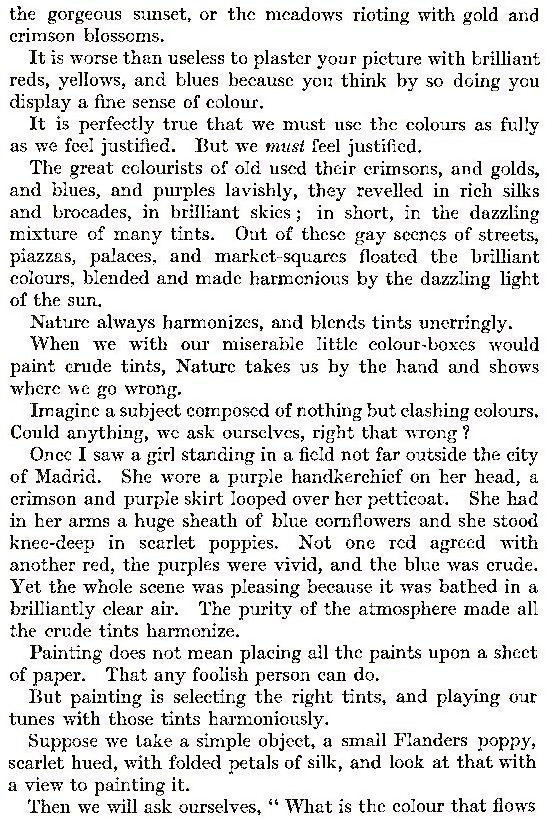
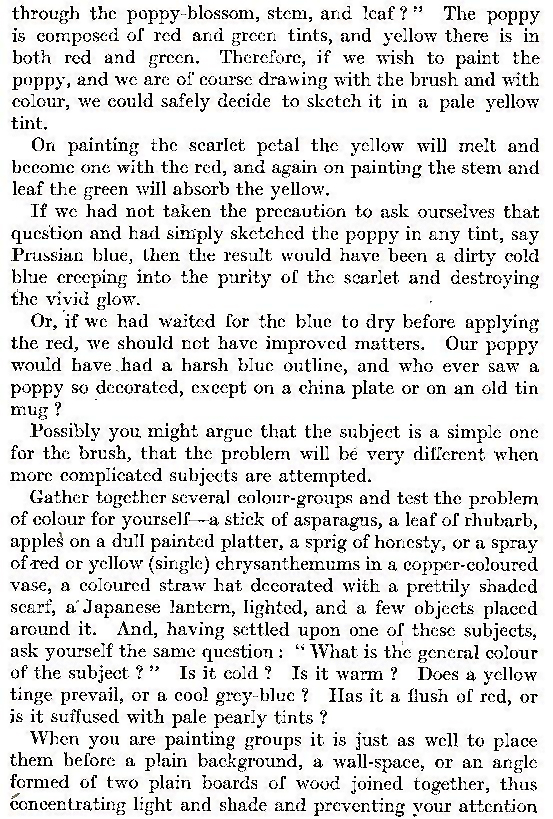
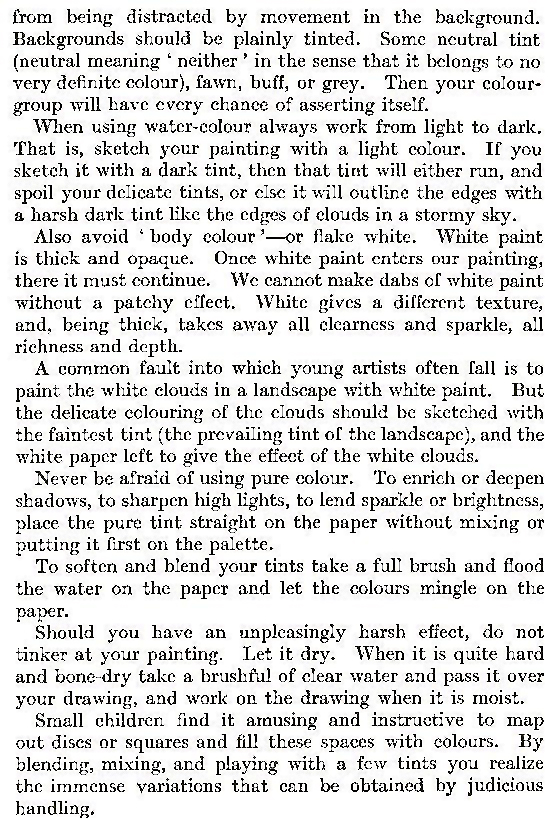
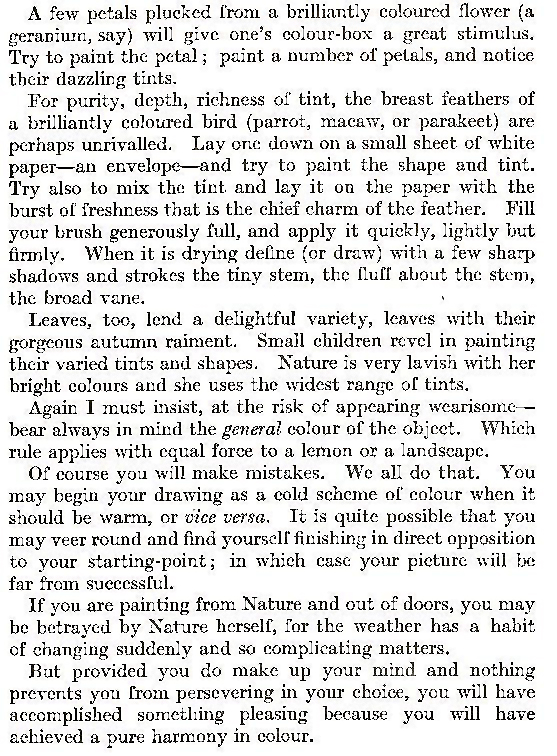
GO BACK TO THE HOME PAGE FOR TUTORIALS FOR BEGINNING ARTISTS
[The above words are pictures of text, below is the actual text if you need to copy a paragraph or two]
Colours, and how to Find Them
Color is the most deceptive thing under the sun. No two people see colour in exactly the same way, no two people reproduce or paint—colour with exactly the same blending of tints.
If a colour-group is placed before several young artists with paint-boxes in their hands, we shall not find—providing, of course, that they are not copying each other—the artists choosing the same tints wherewith to paint the same objects. In all probability every painting would be quite different. Which proves that colour appeals to all of us in varied degrees.
Painting is not a mere matching of tints, or placing one tint against another tint.
We might begin our picture with a conscientious desire to match every colour exactly and yet produce something horribly wrong.
Because we began with a wrong idea in our head. We started from an entirely false basis.
We must not begin by asking ourselves, " Is that an orange, blue, or green tint ? " but, " What is the colour that pervades and envelops the whole ? "
Have you ever walked in the meadows or down a street in a city and remarked to yourself how different everything looked when last you were there ?
Perhaps it was then a brilliantly sunny day, and on the day on which you made the remark the same street was dripping and shining from recent rain-storms. It would indeed be different. Then the sun filled every chink and shadow with golden warmth. It played on the fronts of the houses, it sparkled on the window-frames, it picked out the red flush of the bricks, it spied the orange peel in the gutter,the jewels of a lady walking along the street. It was a gay scene, beneath sunny blue skies dashed with warm clouds. And the charm of the country scene would be even more intensified by the brilliancy of the clear air and bright sun, which emphasizes the lichen on the cottage-roof and walls, the yellow in the old flagstones, the gleaming of the ricks, the rich shadows flung by the soft green foliage of the tall trees. Then—the next time!
Heavy rains swept the streets or drenched the meadows, clouds hung dark and threatening, pavements gleamed coldly, the muddy lanes were glittering, heavy foliage dripping, thick soft mists arising, all was wet, grey, and cold. There were dull shadows where the people walked the streets, the tops of the houses were shrouded in murky fog, and in the country lanes the cows moved between the heavy hedges wrapped in a moist cold air.
Do you realize that there must always be one general hue that envelops, and blends, and harmonizes?
Have not you sometimes said of a painting, " I don't know what is the matter with that picture . . . but I don't like it " ? You have a very definite reason, but you cannot put it in words. You don't like it, and if you lived to be a hundred you feel you would never like it more or hate it less. In other words, you feel there is something that jars upon you. If we tried to analyse your feelings about that picture, we should probably discover that a crash of discords upon the piano bore a strong resemblance to the jarring colours of the picture.
The man who painted the picture did not try to discover the general colour that ran through his picture, and blend it harmoniously together ; but, like a simultaneous crash of all the notes on the piano, he banged every tint thick and fast upon his canvas.
On certain islands in the South Seas the native mothers fill hollowed-out trunks of trees with water and in this water boldly place their infants, and the babies swim.
From this example some people argue that all babies will swim as naturally as they will later walk and talk.
On that particular point I am not prepared to give an opinion, but this I do know, for it has been often proved : if we put a box of chalks into the hands of a small child of four or five, the child will as often as not use the colours rightly and naturally. I have seen paintings by tiny children as good as any done by practised artists. Give the child a string of beads, a coloured ball, a bunch of cherries, or a twisted morsel of coloured thread, and Baby will chalk these colours with astonishing ease. The shape may be funny, but the colour will be pure, fresh, and sweet. Which proves that the sense of colour is a natural sense.
It is a very stimulating thought that we are born with this delightful gift, which only needs a natural development.
As we grow older, and more diffident of ourselves, we seek out rules and hamper ourselves with stupid regulations. But if we merely ask ourselves a few simple guiding questions, such as, " What is the general colour of the thing that I wish to paint ? " and keep our mind focused on that one thing, our troubles will melt away.
Each colour depends to a great extent on its surroundings.
There's Timmy, the tabby cat, for instance. What colour would you call his coat and eyes ? " A buff fur striped with sharp black lines, and yellow eyes," you would most probably reply.
But look at Timmy lying on the summer grass. His buff and white fur reflects the green of the grass ; his glossy black stripes fade in the sun like old silver, and deepen in shadow like the rich dark colour of the tree-bark ; his eyes, most curious of all, empty into round pools of colourless light. Thinking of Timmy's colouring suggests another subject on which we have not time to dwell—the protective nature of colour. It also reminds us that colour is influenced by other surrounding colours.
" What is colour ? " cries the young artist.
We say that black is black and white is white, that snow is white, the clean linen handkerchief is white, the ermine fur that you wear round your neck is white. Drop your handkerchief upon the snow, lay your ermine on its unbroken surface, the one will look murky and grey and the other yellow.
Black is just black, you say. But is it ? Objects are black because they come in contrast with other colours.
Search about for black things in the room. You will see that there are as many shades in black as there are in other tints, according to the light in which the black object is placed, and also according to the colours with which it is surrounded.
Look at the black coat of a man in a subdued light, when, for instance, he is sitting in a room ; and look at the same black coat when the man is walking out in the streets under the blue sky.
The black coat under a subdued quiet light is deep and rich and warm, but in the open air the light strikes on the shoulders, the arms, and the skirts of the coat, and if a cold blue light is reflected from the sky, then the black coat will reflect that colour and tint. Obviously, being a dark material, it will absorb ; but light and shade there must be, and the black will mingle with the general colouring of the street.
' A sense of colour ' in the mind of an artist is simply the faculty of choosing tints.
One artist may revel in exquisite golds, reds, and blues ; another may prefer silvery greys and blues, warm fawn, and dull reds.
But it is not true to say that the latter has not as much sense of colour as the former. His choice of tints is different. He sees Nature in more subdued hues. That is all. His theme of colouring is quieter, more subtle.
If your taste inclines to more delicate shades, do not be discouraged because by that choice you are told you haven't much sense of colour. That you know in your heart of hearts is not true. The beauty of twilight, or the delicacy of a misty landscape, or the sombreness of the grey old woman in her dark frock have fully as much ' colour' as the gorgeous sunset, or the meadows rioting with gold and crimson blossoms.
It is worse than useless to plaster your picture with brilliant reds, yellows, and blues because you think by so doing you display a fine sense of colour.
It is perfectly true that we must use the colours as fully as we feel justified. But we must feel justified.
The great colourists of old used their crimsons, and golds, and blues, and purples lavishly, they revelled in rich silks and brocades, in brilliant skies ; in short, in the dazzling mixture of many tints. Out of these gay scenes of streets, piazzas, palaces, and market-squares floated the brilliant colours, blended and made harmonious by the dazzling light of the sun.
Nature always harmonizes, and blends tints unerringly.
When we with our miserable little colour-boxes would paint crude tints, Nature takes us by the hand and shows where we go wrong.
Imagine a subject composed of nothing but clashing colours. Could anything, we ask ourselves, right that wrong?
Once I saw a girl standing in a field not far outside the city of Madrid. She wore a purple handkerchief on her head, a crimson and purple skirt looped over her petticoat. She had in her arms a huge sheath of blue cornflowers and she stood knee-deep in scarlet poppies. Not one red agreed with another red, the purples were vivid, and the blue was crude. Yet the whole scene was pleasing because it was bathed in a brilliantly clear air. The purity of the atmosphere made all the crude tints harmonize.
Painting does not mean placing all the paints upon a sheet of paper. That any foolish person can do.
But painting is selecting the right tints, and playing our tunes with those tints harmoniously.
Suppose we take a simple object, a small Flanders poppy, scarlet hued, with folded petals of silk, and look at that with a view to painting it.
Then we will ask ourselves, " What is the colour that flows through the poppy-blossom, stem, and leaf ? " The poppy is composed of red and green tints, and yellow there is in both red and green. Therefore, if we wish to paint the poppy, and we are of course drawing with the brush and with colour, we could safely decide to sketch it in a pale yellow tint.
On painting the scarlet petal the yellow will melt and become one with the red, and again on painting the stem and leaf the green will absorb the yellow.
If we had not taken the precaution to ask ourselves that queition and had simply sketched the poppy in any tint, say Prussian blue, then the result would have been a dirty cold blue creeping into the purity of the scarlet and destroying the vivid glow.
Or, if we had waited for the blue to dry before applying the red, we should not have improved matters. Our poppy would have had a harsh blue outline, and who ever saw a poppy so decorated, except on a china plate or on an old tin mug?
Possibly you might argue that the subject is a simple one for the brush, that the problem will be very different when more complicated subjects are attempted.
Gather together several colour-groups and test the problem of colour for yourself—a stick of asparagus, a leaf of rhubarb, appleg on a dull painted platter, a sprig of honesty, or a spray of-red or yellow (single) chrysanthemums in a copper-coloured vase, a coloured straw hat decorated with a prettily shaded scarf, a' Japanese lantern, lighted, and a few objects placed around it. And, having settled upon one of these subjects, ask yourself the same question : " What is the general colour of the subject ? " Is it cold ? Is it warm ? Does a yellow tinge prevail, or a cool grey-blue ? Has it a flush of red, or is it suffused with pale pearly tints ?
When you are painting groups it is just as well to place them before a plain background, a wall-space, or an angle formed of two plain boards of wood joined together, thus concentrating light and shade and preventing your attention from being distracted by movement in the background. Backgrounds should be plainly tinted. Some neutral tint (neutral meaning ' neither ' in the sense that it belongs to no very definite colour), fawn, buff, or grey. Then your colour-group will have every chance of asserting itself.
When using water-colour always work from light to dark. That is, sketch your painting with a light colour. If you sketch it with a dark tint, then that tint will either run, and spoil your delicate tints, or else it will outline the edges with a harsh dark tint like the edges of clouds in a stormy sky.
Also avoid ' body colour '—or flake white. White paint is thick and opaque. Once white paint enters our painting, there it must continue. We cannot make dabs of white paint without a patchy effect. White gives a different texture, and, being thick, takes away all clearness and sparkle, all richness and depth.
A common fault into which young artists often fall is to paint the white clouds in a landscape with white paint. But the delicate colouring of the clouds should be sketched with the faintest tint (the prevailing tint of the landscape), and the white paper left to give the effect of the white clouds.
Never be afraid of using pure colour. To enrich or deepen shadows, to sharpen high lights, to lend sparkle or brightness, place the pure tint straight on the paper without mixing or putting it first on the palette.
To soften and blend your tints take a full brush and flood the water on the paper and let the colours mingle on the paper.
Should you have an unpleasingly harsh effect, do not tinker at your painting. Let it dry. When it is quite hard and bone-dry take a brushful of clear water and pass it over your drawing, and work on the drawing when it is moist.
Small children find it amusing and instructive to map out discs or squares and fill these spaces with colours. By blending, mixing, and playing with a few tints you realize the immense variations that can be obtained by judicious handling.
A few petals plucked from a brilliantly coloured flower (a geranium, say) will give one's colour-box a great stimulus. Try to paint the petal ; paint a number of petals, and notice their dazzling tints.
For purity, depth, richness of tint, the breast feathers of a brilliantly coloured bird (parrot, macaw, or parakeet) are perhaps unrivalled. Lay one down on a small sheet of white paper—an envelope—and try to paint the shape and tint. Try also to mix the tint and lay it on the paper with the burst of freshness that is the chief charm of the feather. Fill your brush generously full, and apply it quickly, lightly but firmly. When it is drying define (or draw) with a few sharp shadows and strokes the tiny stem, the fluff about the stem, the broad vane.
Leaves, too, lend a delightful variety, leaves with their gorgeous autumn raiment. Small children revel in painting their varied tints and shapes. Nature is very lavish with her bright colours and she uses the widest range of tints.
Again I must insist, at the risk of appearing wearisome—bear always in mind the general colour of the object. Which rule applies with equal force to a lemon or a landscape.
Of course you will make mistakes. We all do that. You may begin your drawing as a cold scheme of colour when it should be warm, or vice versa. It is quite possible that you may veer round and find yourself finishing in direct opposition to your starting-point ; in which case your picture will be far from successful.
If you are painting from Nature and out of doors, you may be betrayed by Nature herself, for the weather has a habit of changing suddenly and so complicating matters.
But provided you do make up your mind and nothing prevents you from persevering in your choice, you will have accomplished something pleasing because you will have achieved a pure harmony in colour.
Privacy Policy .... Contact Us




